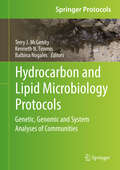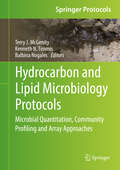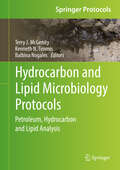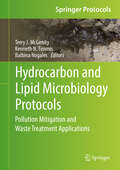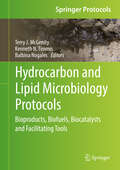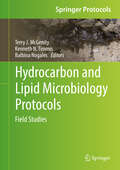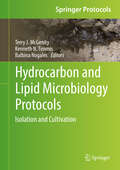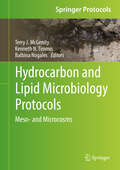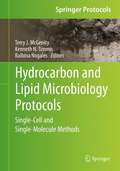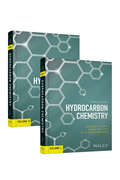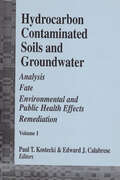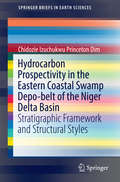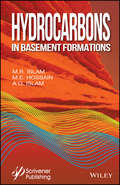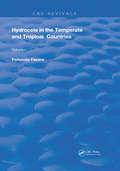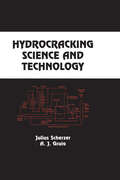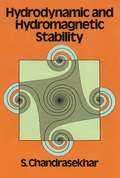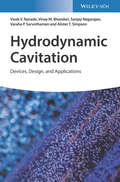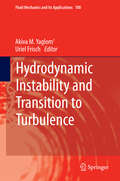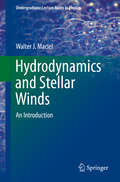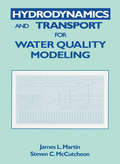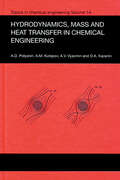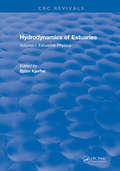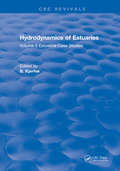- Table View
- List View
Hydrocarbon and Lipid Microbiology Protocols
by Terry J. Mcgenity Kenneth N. Timmis Balbina NogalesThis Volume addresses the pros and cons of oligonucleotide probes, primers and primer combinations, and importantly considers how to design the best tools for the microbial taxa and/or processes being investigated. Individual chapters focus on the design of primers targeting genes that code for enzymes associated with the following functions: degradation of aromatic, aliphatic and chlorinated hydrocarbons under aerobic and anaerobic conditions, methanogenesis, methane oxidation, and the nitrogen cycle. Hydrocarbon and Lipid Microbiology Protocols There are tens of thousands of structurally different hydrocarbons, hydrocarbon derivatives and lipids, and a wide array of these molecules are required for cells to function. The global hydrocarbon cycle, which is largely driven by microorganisms, has a major impact on our environment and climate. Microbes are responsible for cleaning up the environmental pollution caused by the exploitation of hydrocarbon reservoirs and will also be pivotal in reducing our reliance on fossil fuels by providing biofuels, plastics and industrial chemicals. Gaining an understanding of the relevant functions of the wide range of microbes that produce, consume and modify hydrocarbons and related compounds will be key to responding to these challenges. This comprehensive collection of current and emerging protocols will facilitate acquisition of this understanding and exploitation of useful activities of such microbes.
Hydrocarbon and Lipid Microbiology Protocols
by Terry J. Mcgenity Kenneth N. Timmis Balbina NogalesThis Volume addresses the pros and cons of oligonucleotide probes, primers and primer combinations, and importantly considers how to design the best tools for the microbial taxa and/or processes being investigated. Individual chapters focus on the design of primers targeting genes that code for enzymes associated with the following functions: degradation of aromatic, aliphatic and chlorinated hydrocarbons under aerobic and anaerobic conditions, methanogenesis, methane oxidation, and the nitrogen cycle. Hydrocarbon and Lipid Microbiology Protocols There are tens of thousands of structurally different hydrocarbons, hydrocarbon derivatives and lipids, and a wide array of these molecules are required for cells to function. The global hydrocarbon cycle, which is largely driven by microorganisms, has a major impact on our environment and climate. Microbes are responsible for cleaning up the environmental pollution caused by the exploitation of hydrocarbon reservoirs and will also be pivotal in reducing our reliance on fossil fuels by providing biofuels, plastics and industrial chemicals. Gaining an understanding of the relevant functions of the wide range of microbes that produce, consume and modify hydrocarbons and related compounds will be key to responding to these challenges. This comprehensive collection of current and emerging protocols will facilitate acquisition of this understanding and exploitation of useful activities of such microbes.
Hydrocarbon and Lipid Microbiology Protocols
by Terry J. Mcgenity Kenneth N. Timmis Balbina NogalesThis Volume addresses the pros and cons of oligonucleotide probes, primers and primer combinations, and importantly considers how to design the best tools for the microbial taxa and/or processes being investigated. Individual chapters focus on the design of primers targeting genes that code for enzymes associated with the following functions: degradation of aromatic, aliphatic and chlorinated hydrocarbons under aerobic and anaerobic conditions, methanogenesis, methane oxidation, and the nitrogen cycle. Hydrocarbon and Lipid Microbiology Protocols There are tens of thousands of structurally different hydrocarbons, hydrocarbon derivatives and lipids, and a wide array of these molecules are required for cells to function. The global hydrocarbon cycle, which is largely driven by microorganisms, has a major impact on our environment and climate. Microbes are responsible for cleaning up the environmental pollution caused by the exploitation of hydrocarbon reservoirs and will also be pivotal in reducing our reliance on fossil fuels by providing biofuels, plastics and industrial chemicals. Gaining an understanding of the relevant functions of the wide range of microbes that produce, consume and modify hydrocarbons and related compounds will be key to responding to these challenges. This comprehensive collection of current and emerging protocols will facilitate acquisition of this understanding and exploitation of useful activities of such microbes.
Hydrocarbon and Lipid Microbiology Protocols
by Terry J. Mcgenity Kenneth N. Timmis Balbina NogalesThis Volume addresses the pros and cons of oligonucleotide probes, primers and primer combinations, and importantly considers how to design the best tools for the microbial taxa and/or processes being investigated. Individual chapters focus on the design of primers targeting genes that code for enzymes associated with the following functions: degradation of aromatic, aliphatic and chlorinated hydrocarbons under aerobic and anaerobic conditions, methanogenesis, methane oxidation, and the nitrogen cycle. Hydrocarbon and Lipid Microbiology Protocols There are tens of thousands of structurally different hydrocarbons, hydrocarbon derivatives and lipids, and a wide array of these molecules are required for cells to function. The global hydrocarbon cycle, which is largely driven by microorganisms, has a major impact on our environment and climate. Microbes are responsible for cleaning up the environmental pollution caused by the exploitation of hydrocarbon reservoirs and will also be pivotal in reducing our reliance on fossil fuels by providing biofuels, plastics and industrial chemicals. Gaining an understanding of the relevant functions of the wide range of microbes that produce, consume and modify hydrocarbons and related compounds will be key to responding to these challenges. This comprehensive collection of current and emerging protocols will facilitate acquisition of this understanding and exploitation of useful activities of such microbes.
Hydrocarbon and Lipid Microbiology Protocols
by Terry J. Mcgenity Kenneth N. Timmis Balbina NogalesThis Volume addresses the pros and cons of oligonucleotide probes, primers and primer combinations, and importantly considers how to design the best tools for the microbial taxa and/or processes being investigated. Individual chapters focus on the design of primers targeting genes that code for enzymes associated with the following functions: degradation of aromatic, aliphatic and chlorinated hydrocarbons under aerobic and anaerobic conditions, methanogenesis, methane oxidation, and the nitrogen cycle. Hydrocarbon and Lipid Microbiology Protocols There are tens of thousands of structurally different hydrocarbons, hydrocarbon derivatives and lipids, and a wide array of these molecules are required for cells to function. The global hydrocarbon cycle, which is largely driven by microorganisms, has a major impact on our environment and climate. Microbes are responsible for cleaning up the environmental pollution caused by the exploitation of hydrocarbon reservoirs and will also be pivotal in reducing our reliance on fossil fuels by providing biofuels, plastics and industrial chemicals. Gaining an understanding of the relevant functions of the wide range of microbes that produce, consume and modify hydrocarbons and related compounds will be key to responding to these challenges. This comprehensive collection of current and emerging protocols will facilitate acquisition of this understanding and exploitation of useful activities of such microbes.
Hydrocarbon and Lipid Microbiology Protocols
by Terry J. Mcgenity Kenneth N. Timmis Balbina NogalesThis Volume addresses the pros and cons of oligonucleotide probes, primers and primer combinations, and importantly considers how to design the best tools for the microbial taxa and/or processes being investigated. Individual chapters focus on the design of primers targeting genes that code for enzymes associated with the following functions: degradation of aromatic, aliphatic and chlorinated hydrocarbons under aerobic and anaerobic conditions, methanogenesis, methane oxidation, and the nitrogen cycle. Hydrocarbon and Lipid Microbiology Protocols There are tens of thousands of structurally different hydrocarbons, hydrocarbon derivatives and lipids, and a wide array of these molecules are required for cells to function. The global hydrocarbon cycle, which is largely driven by microorganisms, has a major impact on our environment and climate. Microbes are responsible for cleaning up the environmental pollution caused by the exploitation of hydrocarbon reservoirs and will also be pivotal in reducing our reliance on fossil fuels by providing biofuels, plastics and industrial chemicals. Gaining an understanding of the relevant functions of the wide range of microbes that produce, consume and modify hydrocarbons and related compounds will be key to responding to these challenges. This comprehensive collection of current and emerging protocols will facilitate acquisition of this understanding and exploitation of useful activities of such microbes.
Hydrocarbon and Lipid Microbiology Protocols
by Terry J. Mcgenity Kenneth N. Timmis Balbina NogalesThis Volume presents generic protocols for wet experimental and computer-based systems and synthetic biology approaches relevant to the field of hydrocarbon and lipid microbiology. It complements a second Volume that describes protocols for systems and synthetic biology applications. The wet experimental tools presented in this Volume include protocols for the standardisation of transcriptional measurements, application of uracil excision-based DNA editing for, inter alia, multi-gene assembly, the use of fluxomics to optimise "reducing power availability", and the incorporation of non-canonical amino acids into proteins for optimisation of activities. Phenome-ing microbes, using a combination of RNA-seq and bioinformatic algorithms, is presented, as is an illustration, using methylotrophs as an example, of how the different key omics approaches constitute a pipeline for functional analysis, acquisition of a systems overview, and metabolic optimisation. Complementary computational tools that are presented include protocols for probing the genome architecture of regulatory networks, genome-scale metabolic reconstruction, and bioinformatic approaches to guide metabolic engineering. The Volume also includes an overview of how synthetic biology approaches can be used to improve biocontainment. Hydrocarbon and Lipid Microbiology Protocols There are tens of thousands of structurally different hydrocarbons, hydrocarbon derivatives and lipids, and a wide array of these molecules are required for cells to function. The global hydrocarbon cycle, which is largely driven by microorganisms, has a major impact on our environment and climate. Microbes are responsible for cleaning up the environmental pollution caused by the exploitation of hydrocarbon reservoirs and will also be pivotal in reducing our reliance on fossil fuels by providing biofuels, plastics and industrial chemicals. Gaining an understanding of the relevant functions of the wide range of microbes that produce, consume and modify hydrocarbons and related compounds will be key to responding to these challenges. This comprehensive collection of current and emerging protocols will facilitate acquisition of this understanding and exploitation of useful activities of such microbes.
Hydrocarbon and Lipid Microbiology Protocols
by Terry J. Mcgenity Kenneth N. Timmis Balbina NogalesThis Volume presents generic protocols for wet experimental and computer-based systems and synthetic biology approaches relevant to the field of hydrocarbon and lipid microbiology. It complements a second Volume that describes protocols for systems and synthetic biology applications. The wet experimental tools presented in this Volume include protocols for the standardisation of transcriptional measurements, application of uracil excision-based DNA editing for, inter alia, multi-gene assembly, the use of fluxomics to optimise "reducing power availability", and the incorporation of non-canonical amino acids into proteins for optimisation of activities. Phenome-ing microbes, using a combination of RNA-seq and bioinformatic algorithms, is presented, as is an illustration, using methylotrophs as an example, of how the different key omics approaches constitute a pipeline for functional analysis, acquisition of a systems overview, and metabolic optimisation. Complementary computational tools that are presented include protocols for probing the genome architecture of regulatory networks, genome-scale metabolic reconstruction, and bioinformatic approaches to guide metabolic engineering. The Volume also includes an overview of how synthetic biology approaches can be used to improve biocontainment. Hydrocarbon and Lipid Microbiology Protocols There are tens of thousands of structurally different hydrocarbons, hydrocarbon derivatives and lipids, and a wide array of these molecules are required for cells to function. The global hydrocarbon cycle, which is largely driven by microorganisms, has a major impact on our environment and climate. Microbes are responsible for cleaning up the environmental pollution caused by the exploitation of hydrocarbon reservoirs and will also be pivotal in reducing our reliance on fossil fuels by providing biofuels, plastics and industrial chemicals. Gaining an understanding of the relevant functions of the wide range of microbes that produce, consume and modify hydrocarbons and related compounds will be key to responding to these challenges. This comprehensive collection of current and emerging protocols will facilitate acquisition of this understanding and exploitation of useful activities of such microbes.
Hydrocarbon and Lipid Microbiology Protocols: Single-Cell and Single-Molecule Methods (Springer Protocols Handbooks #0)
by Terry J. McGenity Kenneth N. Timmis Balbina NogalesThis Volume presents relevant single-cell and single-molecule approaches in the study of microbes producing and utilizing hydrocarbons and lipids. While generically applicable for all microorganisms, the approaches described are, wherever possible, adapted to the field of study of hydrocarbon and lipid microbiology. The methods include basic procedures for isolating single cells by means of microfluidics and flow cytometry, and their cultivation in arrays as pure clones; for isolating, amplifying and sequencing single-cell genomes and transcriptomes; and for analysing single-cell metabolomes by means of Raman spectroscopy. Single-molecule approaches include the use of protein:fluorescent dye fusions for protein localization and methods for the production of cell division protostructures and lipid monolayers. Methods for the functional analysis of single cells include detection of metabolically active (protein-synthesizing) cells in environmental samples by bioorthogonal non-canonical amino acid tagging, Raman spectroscopy combined with stable isotope labelling and fluorescent in situ hybridisation, and visualization of single cells participating in gene transfer activity. Lastly, protocols are presented for single-cell biotechnological applications, including biofuel production.Hydrocarbon and Lipid Microbiology ProtocolsThere are tens of thousands of structurally different hydrocarbons, hydrocarbon derivatives and lipids, and a wide array of these molecules are required for cells to function. The global hydrocarbon cycle, which is largely driven by microorganisms, has a major impact on our environment and climate. Microbes are responsible for cleaning up the environmental pollution caused by the exploitation of hydrocarbon reservoirs and will also be pivotal in reducing our reliance on fossil fuels by providing biofuels, plastics and industrial chemicals. Gaining an understanding of the relevant functions of the wide range of microbes that produce, consume and modify hydrocarbons and related compounds will be key to responding to these challenges. This comprehensive collection of current and emerging protocols will facilitate acquisition of this understanding and exploitation of useful activities of such microbes.
Hydrocarbon and Lipid Microbiology Protocols
by Balbina Nogales Kenneth N. Timmis Terry J. McgenityThis Volume addresses the pros and cons of oligonucleotide probes, primers and primer combinations, and importantly considers how to design the best tools for the microbial taxa and/or processes being investigated. Individual chapters focus on the design of primers targeting genes that code for enzymes associated with the following functions: degradation of aromatic, aliphatic and chlorinated hydrocarbons under aerobic and anaerobic conditions, methanogenesis, methane oxidation, and the nitrogen cycle. "Hydrocarbon and Lipid Microbiology Protocols" There are tens of thousands of structurally different hydrocarbons, hydrocarbon derivatives and lipids, and a wide array of these molecules are required for cells to function. The global hydrocarbon cycle, which is largely driven by microorganisms, has a major impact on our environment and climate. Microbes are responsible for cleaning up the environmental pollution caused by the exploitation of hydrocarbon reservoirs and will also be pivotal in reducing our reliance on fossil fuels by providing biofuels, plastics and industrial chemicals. Gaining an understanding of the relevant functions of the wide range of microbes that produce, consume and modify hydrocarbons and related compounds will be key to responding to these challenges. This comprehensive collection of current and emerging protocols will facilitate acquisition of this understanding and exploitation of useful activities of such microbes.
Hydrocarbon Chemistry
by George A. Olah G. K. Prakash Arpad MolnarThis book provides an unparalleled contemporary assessment of hydrocarbon chemistry – presenting basic concepts, current research, and future applications.• Comprehensive and updated review and discussion of the field of hydrocarbon chemistry• Includes literature coverage since the publication of the previous edition• Expands or adds coverage of: carboxylation, sustainable hydrocarbons, extraterrestrial hydrocarbons• Addresses a topic of special relevance in contemporary science, since hydrocarbons play a role as a possible replacement for coal, petroleum oil, and natural gas as well as their environmentally safe use• Reviews of prior edition: “...literature coverage is comprehensive and ideal for quickly reviewing specific topics...of most value to industrial chemists...” (Angewandte Chemie) and “...useful for chemical engineers as well as engineers in the chemical and petrochemical industries.” (Petroleum Science and Technology)
Hydrocarbon Contaminated Soils and Groundwater: Analysis, Fate, Environmental & Public Health Effects, & Remediation, Volume I
by Paul T. Kostecki Edward J. Calabrese Charles E. BellProceedings of the February 19-22, 1990, conference held at Newport Beach, California. ConferenceDirectors: PAUL T. KOSTECKI, EDWARD J. CALABRESE, and CHARLES E. BELL. Advisory Committee: RICHARD BOZEK, EEI; TERRY BRAZEL, SWRCB; MARK COUSINEAU, AG; SETH DAUGHERTY, Orange County; RALPH De La PARRA, SCE; JERRY HAGGY, Shell; JOHN HANBY, HAL; JOHN HILL, ICF; JOHN HILLS, City of Anaheim; DOROTHY KEECH, Chevron; BILL KUCHARSKI, WC; DAVID LEU, Mittel Hauser; MARY McLEARN, EPRI; PHIL OLWIN, Texaco; DENNIS PAUSTENBACH, MC; ART POPE, ARCO; LYNNE PRESLO, Weston; DON ROTHENBAUM, KA; KIM SAVAGE, EPA/OUST; CARL SHUBERT, IT; WENDELL SUYAMA, Lockheed; MICHAEL WANG, WSPA; JOHN WILLIAMS, TT; and WILLIAM WINTERS, AEM.
Hydrocarbon Prospectivity in the Eastern Coastal Swamp Depo-belt of the Niger Delta Basin
by Chidozie Izuchukwu Princeton DimThis book broadens readers' understanding of the stratigraphic framework and structural styles for improved hydrocarbon prospectivity in the intermediate and deeper horizons of the eastern Coastal Swamp Depo-belt of Nigeria's Niger Delta Basin. It equips readers to interpret complex sedimentary units, such as the paralic sequence of the Niger Delta Basin, using sequence stratigraphic tools integrated with well logs, biostratigraphic, paleobathymetric and seismic data. It also offers numerous tips and insights into reservoirs, seals, source rocks and hydrocarbon-type trends/distribution across several production fields, and provides a valuable guide to support exploration and production.
Hydrocarbons in Basement Formations
by M. R. Islam M. E. Hossain A. O. IslamPetroleum and natural gas still remain the single biggest resource for energy on earth. Even as alternative and renewable sources are developed, petroleum and natural gas continue to be, by far, the most used and, if engineering properly, the most cost-effective and efficient, source of energy on the planet. Contrary to some beliefs, the industry can, in fact, be sustainable, from an environmental, economic, and resource perspective. Petroleum and natural gas are, after all, natural sources of energy and do not have to be treated as pariahs. This groundbreaking new text describes hydrocarbons in basement formations, how they can be characterized and engineered, and how they can be engineered properly, to best achieve sustainability. Covering the basic theories and the underlying scientific concepts, the authors then go on to explain the best practices and new technologies and processes for utilizing basement formations for the petroleum and natural gas industries. Covering all of the hottest issues in the industry, from oil shale, tar sands, and hydraulic fracturing, this book is a must-have for any engineer working in the industry. This textbook is an excellent resource for petroleum engineering students, reservoir engineers, supervisors & managers, researchers and environmental engineers for planning every aspect of rig operations in the most sustainable, environmentally responsible manner, using the most up-to-date technological advancements in equipment and processes.
Hydrocele in the Temperate and Tropical Countries: Volume 1 (Routledge Revivals)
by Fortunato FasanaFirst published in 1983: This monograph is intended to collate hundreds of studies found in the literature; part of it consists of personal observations made and experience acquired in India, Uganda, and Kenya over the past 30 years.
Hydrocracking Science and Technology (Chemical Industries)
by Julius Scherzer A.J. GruiaPresents advances in the field of hydrocracking. The volume includes catalytic materials, reaction mechanisms and pathways, as well as hydrocracking processes and applications. It discusses hydrocracking processes and hydrocracking technology in catalytic dewaxing, resid upgrading, and fluid catalytic cracking feedstock improvement
Hydrodynamic and Hydromagnetic Stability
by S. ChandrasekharDr. Chandrasekhar's book received high praise when it first appeared in 1961 as part of Oxford University Press' International Series of Monographs on Physics. Since then it has been reprinted numerous times in its expensive hardcover format. This first lower-priced, sturdy paperback edition will be welcomed by graduate physics students and scientists familiar with Dr. Chandrasekhar's work, particularly in light of the resurgence of interest in the Rayleigh-Bénard problem.This book presents a most lucid introduction to the Rayleigh-Bénard problem: it has also been applauded for its thorough, clear coverage of the theory of instabilities causing convection.Dr. Chandrasekhar considers most of the typical problems in hydromagnetic stability, with the exception of viscous shear flow; a specialized domain deserving a book unto itself. Contents include: Rotation; Stability of More General Flows; Bénard Problem; Gravitational Equilibrium and Instability; Stability of a Magnetic Field; Thermal Instability of a Layer of Fluid heated from Below; Rayleigh-Taylor Instability; Kelvin-Helmholtz Instability; and Onset of Thermal Instability in Fluid Spheres and Spherical Shells.Each chapter is accompanied by a section of bibliographical notes: indexes locating definitions and theorems are also provided. Graduate students in theoretical and experimental physics, as well as physicists in diverse fields, will immediately remark upon the clear exposition, and be glad this book is now so readily available.
Hydrodynamic Cavitation: Devices, Design and Applications
by Vivek V. Ranade Vinay M. Bhandari Sanjay Nagarajan Varaha P. Sarvothaman Alister T. SimpsonHydrodynamic Cavitation A systematic introduction to critical technologies and applications of hydrodynamic cavitation In Hydrodynamic Cavitation: Devices, Design, and Applications, a distinguished team of researchers delivers an authoritative discussion of key aspects of hydrodynamic cavitation, including the design, characterization, and modeling of the devices. The book offers discussions of state-of-the-art applications of the technology, including the disinfection of water, wastewater treatment, biomass processing, and many other industrial applications. In addition to expansive case studies, the book provides an up-to-date exploration of emerging innovations and future applications of the technology. Readers will also find: A thorough introduction to hydrodynamic cavitation devices, including those based on axial and rotational flows An in-depth examination of the experimental characterization of cavitation devices and computational models Comprehensive explorations of the applications of hydrodynamic cavitation, including the disinfection of water and wastewater treatment Accessible discussions of industrial applications of hydrodynamic cavitation Perfect for chemical and process engineers, water chemists, mechanical engineers, and food chemists, Hydrodynamic Cavitation will also earn a place in the libraries of food and environmental technologists.
Hydrodynamic Control of Wave Energy Devices
by Umesh A. Korde John V. RingwoodWith this self-contained and comprehensive text, students and researchers will gain a detailed understanding of the fundamental aspects of the hydrodynamic control of wave energy converters. Such control is necessary to maximise energy capture for a given device configuration and plays a major role in efforts to make wave energy economic. Covering a wide range of disciplines, the reader is taken from the mathematical and technical fundamentals, through the main pillars of wave energy hydrodynamic control, right through to state-of-the-art algorithms for hydrodynamic control. The various operating principles of wave energy converters are exposed and the unique aspects of the hydrodynamic control problem highlighted, with a variety of potential solutions discussed. Supporting material on wave forecasting and the interaction of the hydrodynamic control problem with other aspects of wave energy device optimisation, such as device geometry optimisation and optimal device array layout, is also provided.
Hydrodynamic Instability and Transition to Turbulence
by Akiva M. Yaglom Uriel FrischThis book is a complete revision of the part of Monin & Yaglom's famous two-volume work "Statistical Fluid Mechanics: Mechanics of Turbulence" that deals with the theory of laminar-flow instability and transition to turbulence. It includes the considerable advances in the subject that have been made in the last 15 years or so. It is intended as a textbook for advanced graduate courses and as a reference for research students and professional research workers. The first two Chapters are an introduction to the mathematics, and the experimental results, for the instability of laminar (or inviscid) flows to infinitesimal (in practice "small") disturbances. The third Chapter develops this linear theory in more detail and describes its application to particular problems. Chapters 4 and 5 deal with instability to finite-amplitude disturbances: much of the material has previously been available only in research papers.
Hydrodynamics and Stellar Winds
by Walter J. MacielIntroduces hydrodynamics to undergraduate students in physics and astrophysics. Stellar winds are a common phenomenon in the life of stars, from the dwarfs like the Sun to the red giants and hot supergiants, constituting one of the basic aspects of modern astrophysics. Stellar winds are a hydrodynamic phenomenon in which circumstellar gases expand towards the interstellar medium. This book presents an elementary introduction to the fundamentals of hydrodynamics with an application to the study of stellar winds. The principles of hydrodynamics have many other applications, so that the book can be used as an introduction to hydrodynamics for students of physics, astrophysics and other related areas.
Hydrodynamics and Transport for Water Quality Modeling
by James L. Martin Steven C. McCutcheonHydrodynamics and Transport for Water Quality Modeling presents a complete overview of current methods used to describe or predict transport in aquatic systems, with special emphasis on water quality modeling. The book features detailed descriptions of each method, supported by sample applications and case studies drawn from the authors' years of experience in the field. Each chapter examines a variety of modeling approaches, from simple to complex. This unique text/reference offers a wealth of information previously unavailable from a single source.The book begins with an overview of basic principles, and an introduction to the measurement and analysis of flow. The following section focuses on rivers and streams, including model complexity and data requirements, methods for estimating mixing, hydrologic routing methods, and unsteady flow modeling. The third section considers lakes and reservoirs, and discusses stratification and temperature modeling, mixing methods, reservoir routing and water balances, and dynamic modeling using one-, two-, and three-dimensional models. The book concludes with a section on estuaries, containing topics such as origins and classification, tides, mixing methods, tidally averaged estuary models, and dynamic modeling. Over 250 figures support the text.This is a valuable guide for students and practicing modelers who do not have extensive backgrounds in fluid dynamics.
Hydrodynamics, Mass and Heat Transfer in Chemical Engineering
by Andrei D. Polyanin A.M. Kutepov D.A. Kazenin A.V. VyazminHydrodynamics, Mass and Heat Transfer in Chemical Engineering contains a concise and systematic exposition of fundamental problems of hydrodynamics, heat and mass transfer, and physicochemical hydrodynamics, which constitute the theoretical basis of chemical engineering in science. Areas covered include: fluid flows; processes of chemical engineeri
Hydrodynamics of Estuaries: Volume I Estuarine Physics
by B. KjerfveThese books are divided into two volumes. The first focuses on estuarine physics and physical processes and interpretations. I have, for the most parts, intentionally downplayed engineering applications to estuaries. It is my bias that a deeper understanding is accomplished with a physical approach, whereas an engineering approach is largely geared toward finding a solution to a problem. Of course, it is not always easy to make this distinction. The second volume is a presentation of physical case studies of several important estuaries, spanning the major geomorphic types. I believe that it can be very useful to all areas of the world. I have consciously strived to be more international to scope in selection of both authors and estuarine case studies.
Hydrodynamics of Estuaries: Volume II Estuarine Case Studies
by B. KjerfveThese books are divided into two volumes. The first focuses on estuarine physics and physical processes and interpretations. I have, for the most parts, intentionally downplayed engineering applications to estuaries. It is my bias that a deeper understanding is accomplished with a physical approach, whereas an engineering approach is largely geared toward finding a solution to a problem. Of course, it is not always easy to make this distinction. The second volume is a presentation of physical case studies of several important estuaries, spanning the major geomorphic types. I believe that it can be very useful to all areas of the world. I have consciously strived to be more international to scope in selection of both authors and estuarine case studies.
